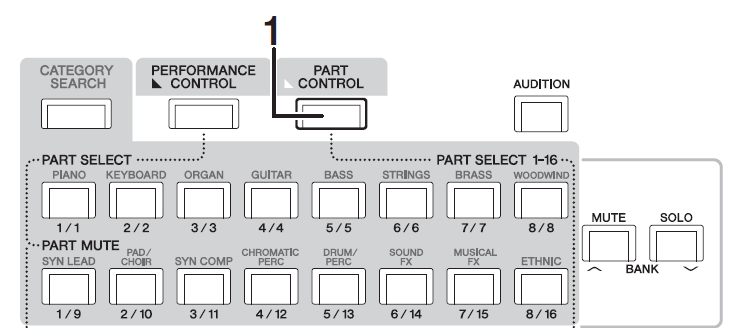Greetings to everyone.
The sound balance of the elements of one of the parts that make up a performance is available on which edit page of the elements ?
The 'Level' setting for an element is on the 'Amplitude' tab available after you:
1. select a part
2. edit the part
3. select an element
See page 121 of the Reference manual
https://usa.yamaha.com/files/download/other_assets/2/1192582/modx_en_rm_c0.pdf
[quotePost id=122122]The 'Level' setting for an element is on the 'Amplitude' tab available after you:
1. select a part
2. edit the part
3. select an element
See page 121 of the Reference manual
thank you
I didn't realise it was in amplitude.
Not a problem.
Sometimes things are hard to find. They use 'level' and 'volume' so you often have to know what to actually search for.
Don't forget that there are several places where that volume/level can be offset including at the part level and performance level.
It can also get changed if you assign it to a controller.
Extra Credit
Each AWM2 Element is a “mini-synth” in that it has all the major components for Pitch/Timbre/Loudness: an Oscillator (waveform), a Filter, and an Amplitude Envelope Generator… it also has its own LFO to generate vibrato/wah-wah/tremolo, and it’s own response to Keyboard input. An Element can be used alone to create an instrument or it can be a building-block, 1 of 8, within a Part.
Different ways to look at the data
You can view the individual Elements by ‘menu diving’ to the Part Edit > Element1-8 > Amplitude > Level/Pan screen. You would do this to see the Level among other Amplitude settings. But to view it as part of the sound you are constructing, the MONTAGE/MODX/MODX+ engine gives you several ways to view and compare parameter settings without “deep diving” and having to access 8 separate pages, one at a time, to compile this information. In other words, for convenience a single parameter may appear in various views. (The better you get to know your interface, the better you’ll be able to access the needed data).
Say you want to see an overview that includes all 8 Elements, side-by-side… (again, for convenience)…
To view/access all 8 Elements simultaneously:
From the [HOME] screen
Select Part
[EDIT] > touch “All” bottom of the screen > “All” here gives you two screen options to see an overview of all 8 Elements: “Osc” and “Bal”
“Osc” will give an overview of the potential 8 Waveforms (Oscillators), and their mapping/triggering conditions
“Bal” (Balance) will let you view all 8 Elements and their volume, pan, settings at once.
To gain real-time access to all 8 Elements/Quickest access (from the “MONTAGE: Performance Basics…” article…)
_from the HOME screen
Press [PART CONTROL]
This turns the top two rows of numbered buttons into Part Select [1]-[16] buttons.
Press a PART SELECT button to instantly be in communication with that Part.

_ Try switching between Parts using these two rows of buttons, while [PART CONTROL] is lit. Notice how this is a glitch-free method to move between your favorite single Part programs. Selecting via the front panel buttons is changing the transmit channel so we are accessing a different individual channel and our controllers switch with us. As you access a Part the controller's functions switch with you. You can however, hold the sustain pedal on one PART, move to a new PART and play. Or you can hold the keys of one PART, move to a new PART and play using the sustain pedal on the new PART.
_ Try switching the Faders from controlling Part Volume 1-8, or 9-16, to controlling Element/Operator Volume. Once you've selected a Part via [PART CONTROL], press the [PERFORMANCE CONTROL] button, the FADERs now work to "perform" and "control" the selected PART - and give you Element/Operator Level control.
[PART CONTROL] each FADER controls a Part Volume 1-8 or 9-16
[PERFORMANCE CONTROL] gives FADERs access to the individual Element/Operator levels 1-8 on the selected Part
……………….
You can store a Performance so that the Sliders represent Element Levels (instead of the standard Part Volumes). See the several Single Part B3 Tone Wheel drawbar organ emulations.
Toggle the VIEW button to select View #2, split-screen with Element Sliders
You would dive down to the Element Amplitude page only when programming that Elements individual response. You would use one of the real-time access methods to balance or adjust the output levels.
Additionally, you can assign Element Level to a controller. As you move the cursor around the screen, highlighting a Part parameter, if the [CONTROL ASSIGN] glows, this means it is one of many *assignable* parameters.
In a case where you designate some Elements to function together, you might assign a second group of Elements to only sound under conditions applied by a physical controller (fading in a pad under an acoustic piano, for example).
_In a case where your Element Slider does not behave as expecteed… you will discover it has been assigned an additional controller in the “Control Assign” set. For example, imagine an Element that added percussion harmonic to a B3 Organ sound, you might desire to have real-time access to bring that component in… you can decide to put it on a Switch or fade it in with a pedal or knob, your choice!
